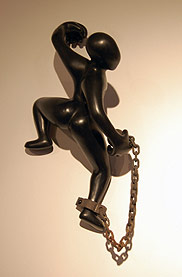
| HOME |
| NERVE |
| REVIEWS |
| ARCHIVE |
| EVENTS |
| LINKS |
| ABOUT US |
| CONTRIBUTORS |
| BACK ISSUES |
| CONTACT US |
 Hawkins
& Co
Hawkins
& Co
Contemporary Arts Centre, Greenland Street
7th March - 5th May 2008, Tue-Sun 11am-6pm
Reviewed by Sandra Gibson
This is an exhibition of artworks by fifteen UK-based and international contemporary artists, exploring aspects of the transatlantic African-Caribbean diaspora in the wake of Elizabethan naval commander Sir John Hawkins, whose voyages pioneered Britain’s slave trade. One of the opening exhibitions at Liverpool’s new Contemporary Urban Centre, it is curated by Kimathi Donkor for Novas Arts and sponsored by the Novas Scarman Group.
A moving and uncompromising experience, this exhibition assails the ears as well as the eyes. The wooden floors of the space creak like sailing ships and there is a relentless sound effect – somewhere between chanting and chugging – I wished would stop. Without exception these works concern the narrative power of the storyteller. You will find no charming and gentle landscapes; no slick conceptual stuff; no clever post-modernist self-absorption; hardly any abstraction. No: there is a story to be told – not just a historical story but a contemporary one which still resonates with the relentless ocean waves of greed, and in my opinion it is effectively and engagingly told without crossing the line into sensationalism or propaganda.
Pauline Wiggins’ illustrations of the 1919 death of Charles Wooton gain an extra topographical significance when you realise they are positioned next to a window overlooking the area in Parliament Street where the notorious hounding of Wooton took place. His subsequent drowning – tantamount to lynching – took place in the Queen’s Dock. The comic-book style shocks because of its grim content but also grants a degree of detachment whilst referencing the tabloid role in race relations. I found a similar degree of restraint in Bacchus and Ariadne by Kimathi Donkor – a narrative composition of arresting power in which there is no Bacchus to protect Ariadne. The central protagonist, bayonet at the ready, his face a livid white, chases a black boy whilst his compatriot drags a black woman by the hair, watched by his lascivious companion. The painting stops short of the bayoneting and the rape and it is this restraint that gives power both to the painting and to the viewer’s response which in my case was echoed by the figure on the left, immobilised by horror. Kimathi Donkor’s UK Diaspora – a rogues’ gallery of the transatlantic trade in goods and human beings that initiated the diaspora – employs a combination of techniques to convey anger and horror. The most disturbingly eloquent part of these collages of cruelty and greed is their frame of nails. Like the work of Jake and Dinos Chapman the miniaturisation of atrocity – the model soldiers, the model jeeps containing a cargo of black babies, economically and tidily stowed to maximise use of space (and where have we seen that before?) – imposes some restraint but also invites the viewer to look closer and to question the way the mind minimises issues it refuses to address.
Keith Piper’s Working drawings towards a Triptych: A Pirate, An English Queen, A Ship Called Jesus examine the trade in human beings in a way that brings form and content close. The unfinished quality of the work draws attention to the fact that the commodification of human beings is on-going and contemporary – a point also made in Donna Berry’s frieze, History: Elevated from the Page – and the triptych form echoes both the triangular nature of the original transatlantic trade and the three-faceted transaction of exploitative trafficking sublimated as an act of chivalric homage to a faceless monarch. The central panel: a plan of the slave ship so ironically named after the Saviour produces the shock of recognition that all iconic images do and like the timetable for the trains to Auschwitz, appals by the fact of human intelligence put to nefarious ends such as the industrialisation of suffering. The commodification of humans is also addressed in George ‘Fowakan’ Kelly’s work. His range of lovely gold-plated masks called Guineas refers to the British coins associated with the slave trade and named after Guinea in Africa. His Lost Queen of Pernambuco has a beauty that overwhelms all metallic confinement, transforming them into embellishment.
Another work firmly addressing the present as well as the past is Kofi Achiampong’s insistent installation What, What, What…?/Swan Song – a depressing reference to the monkey chanting endemic in European sports venues used here to maximum effect as a form of clamouring auditory torture. The idea has been subverted from the techniques used by the US military to distress and disturb prisoners and permeates the whole exhibition space. The Black stereotype is evoked by the use of black, pink-lipped footballs placed on tall blocks in groups of four or seven, the whole assemblage creating the noisy claustrophobia of fear and greed and dehumanisation found at a slave market.
 So here
we have a succinct and eloquent drawing together of past and present exploitation;
the perpetuation of the stereotype and the abusive public response whether
it be the rapacious football manager or the infantile monkey-chanter.
There is a further refinement to the metaphor of sound and stereotype.
A gun has been amalgamated with a microphone to reference the phenomenon
of gangsta rap – the urban folk-tale of contemporary Black experience
which exists side by side with the world class footballer as – for
some – the epitome of achievement. Achievement marred by the mind
that classifies, that wishes cynically to use and abuse. These issues
are also examined by Jean-Francois Bocle in his refined installations
Banana Call Centre, Monkey Bananas, and Blacks on Black whilst Raimi Gbadamosi
seeks to celebrate uniqueness in the harmonious diversity of Revolution
in a Bottle and Ceremonial Arcade.
So here
we have a succinct and eloquent drawing together of past and present exploitation;
the perpetuation of the stereotype and the abusive public response whether
it be the rapacious football manager or the infantile monkey-chanter.
There is a further refinement to the metaphor of sound and stereotype.
A gun has been amalgamated with a microphone to reference the phenomenon
of gangsta rap – the urban folk-tale of contemporary Black experience
which exists side by side with the world class footballer as – for
some – the epitome of achievement. Achievement marred by the mind
that classifies, that wishes cynically to use and abuse. These issues
are also examined by Jean-Francois Bocle in his refined installations
Banana Call Centre, Monkey Bananas, and Blacks on Black whilst Raimi Gbadamosi
seeks to celebrate uniqueness in the harmonious diversity of Revolution
in a Bottle and Ceremonial Arcade.
Some pieces are more obviously contemporary than others. Barbara Walker’s hand-painted studies add people and place to the cold documents of official prejudice – in this case the ‘stop and search’ forms handed to her son and this links her work with that of Pauline Wiggins’ critique of the treatment of Charles Wooton nearly a century earlier.
Other works are not time- or space-specific. Tam Joseph’s The Flying Doctor is a mesmerising study of the manifestation of menace, be it natural disaster, pestilence or invasion. Chinwe Chukwuogo-Roy’s impressive Dance of the Devils: a danse macabre involving – and here one deduces – a large African leader and a pale louche European watched by guerrilla fighters of various factions and a starving populace. There is a grotesque carnival atmosphere but the fireworks are really shells and the patches of colour on the ground are not the myriad coloured lights from a mirror ball but human beings trampled underfoot. Her examination of the plight of the migrant is based on the 20th and 21st century boat people but the complex feelings of desperation, dread and aspiration which permeate the refugee experience are timeless and well captured in these beautifully drawn paintings [Migration, Migrants No Entry, Migration],where the spaciousness of experience is not confined by the intimate size of the canvases. Chinwe Chukwuogo-Roy’s other claim to fame is her 2002 official portrait of the Queen.
 Faith Bebbington’s
Sniffing the Air is as touching an image of the human condition as any
I’ve seen and has already been sold. Her work acknowledges suffering
whilst at the same time celebrating human aspiration.
Faith Bebbington’s
Sniffing the Air is as touching an image of the human condition as any
I’ve seen and has already been sold. Her work acknowledges suffering
whilst at the same time celebrating human aspiration.
The work of Marcia Brown is deeply influenced by her Rastafarian faith. Paintings such as Sheba Visits and Solomon Meets Sheba reference Biblical events involving great rulers yet they retain an intimacy and a gentleness that keeps them at a human level. There are some rich and beautiful painterly effects which enhance the generosity of these works.
Paul Clarkson’s Jokerman – how the decorative power of this painting holds the viewer! – with its fine portrayal of the uneasy juxtaposition of cultures and Tam Joseph’s Spirit of the Carnival both address the edgy co-existence of cultural difference. In the latter the barricade of police officers around the carnival is disempowered by the child-like depiction of them and subverted by the playfulness and airiness of Carnival.
And perhaps this is the point. After all this history how is transformation to take place? Through politics; through economics? Crudely through the rough-hewn fist? Through the pointless three-way chessboard of global power struggle displayed by Raimi Gbadamosi’s Swadsquad? Through confrontation or through transcendence? Through narrowness of mind or through humour and the playful interplay of energy?
I am indebted to gallery assistant Darren Williams for his courteous hospitality and communicative skill.
Regrettably there was a technical problem preventing me from appreciating Jane Woolner’s work.
Comments:
Comment left by Sandra Gibson on 15th April, 2008 at 19:34
I wonder if someone could review Jane's work? I feel badly that she is the only artist I haven't commented on.
Comment left by johno on 28th May, 2008 at 14:04
totally agree with the comments
first class exhibit only problem was access seemed to be dead no visitors
maybe still growing the word isnt out on the street yet..staff were tres cool darren was a mine of info on the place
Comment left by pete on 4th June, 2008 at 14:36
the CUC has only recently opened and as you may have noticed, there is still extensive work going on in the building. once it's fully operational though expect the gallery to be packed... enjoy it now while you can have some space to think!
Comment left by carla weaver on 7th October, 2009 at 17:08
I also worked with on that show as an invigilator,it was thought provoking and made me so proud to be a part of the contemporary urban centre with artists like those kimathi worked with.we still have madonna metropolitan in our permanent collection and it is one of most favored pieces.Thank you Kimathi